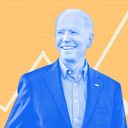White House economists tout full employment and disinflation in new report

Full employment has arrived, and it is marvelous. That, in a sentence, is the Biden White House's view of the labor market in 2024, according to a major report from its in-house economists out Thursday morning.
Why it matters: Biden's re-election hopes hinge on the job market remaining robust — creating wide-ranging benefits for workers — while inflation continues to fall. His economic team argues that is indeed plausible, contrary to inflation-fighting economic orthodoxy.
Driving the news: The Economic Report of the President, issued by the White House Council of Economic Advisers, describes "little evidence" that tight labor markets in the post-pandemic period caused higher inflation than would have been the case otherwise.
- The economists consider previous episodes of full employment — or the maximum level of employment the economy can handle without causing a surge in inflation.
- The precise level of full employment is subject to much debate, with different economic models spitting out various estimates.
What they're saying: "I think we are certainly hovering around full employment," Jared Bernstein, chair of the Council of Economic Advisers, tells Axios. "What we're seeing now is the maintenance of full employment with significant disinflation."
- The CEA argues that if full employment were the central cause of the current inflation surge, the easing of price pressures "should have brought about a substantial slackening of the labor market."
The big picture: Workers are still enjoying many of the side effects of a strong labor market — including shrinking racial and gender gaps in employment and strong bargaining power on the part of workers.
- "The benefits of full employment multiply when the conditions persist," Bernstein says.
Where it stands: For instance, the latest jobs report shows the employment gap between prime-age Black and white workers at a record low.
- Meanwhile, unions have scored historic labor deals in recent years — a sign that workers have the upper hand.
What to watch: The current dynamics of the job market have striking differences from the full employment of pre-pandemic times. On the negative side, strong inflation has eaten away at wage gains.
- But unlike in the 2010s, nominal wages have soared — and now that inflation is subsiding, there are gains in real terms. There's a productivity boom underway allowing that to be the case without inflation fears.
Bernstein also pointed to the Biden administration's efforts to build up domestic manufacturing and invest in green energy.
- "That wasn't happening back then," Bernstein says. "We would characterize this as a period of full employment, with a side of strong investment."
Of note: The chapter on full employment is dedicated to William Spriggs, the former chief economist of the AFL-CIO and passionate advocate for full employment, who died last year.